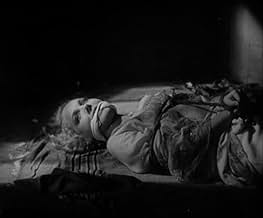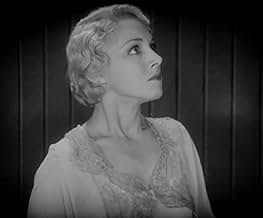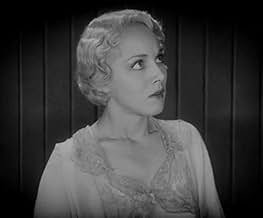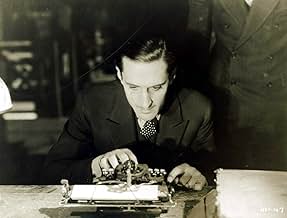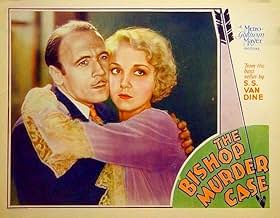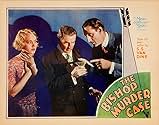Aggiungi una trama nella tua linguaWhen the body of a man nicknamed "Cock Robin" is found with an arrow in the heart on an archery range along with a chess bishop as a clue, Philo Vance investigates.When the body of a man nicknamed "Cock Robin" is found with an arrow in the heart on an archery range along with a chess bishop as a clue, Philo Vance investigates.When the body of a man nicknamed "Cock Robin" is found with an arrow in the heart on an archery range along with a chess bishop as a clue, Philo Vance investigates.
- Regia
- Sceneggiatura
- Star
Charles Quatermaine
- John Pardee
- (as Charles Quartermaine)
Sidney Bracey
- Pyne
- (as Sydney Bracey)
Richard Cramer
- Detective in Park
- (non citato nei titoli originali)
Frank Fanning
- Officer Manning
- (non citato nei titoli originali)
Marcia Mae Jones
- Hungry Child in Park
- (non citato nei titoli originali)
Broderick O'Farrell
- Dr. Van Pelt
- (non citato nei titoli originali)
Recensioni in evidenza
This film is the 3rd of the Philo Vance mysteries to be filmed. The first two, Canary and Greene (filmed in 1929) were pretty hard going. They starred William Powell and he would return to star in the Benson Murder case and the best of the Vance series, The Kennel Murder Case. This one, starring Basil Rathbone is a step above the first two but it is still a static film as were many of that era......transitioning to sound was an awkward time for the movies and people talked, and talked, and talked, ad infinitum. Rathbone, a very attractive, suave actor fits the role well and he plays Vance as a little less of the high-brow, somewhat obnoxious character that was portrayed in VanDine's books. The mystery is another one of those typical Philo Vance puzzlers which never turn out as you thought they might but that is the fun of it all. It's interesting to see Roland Young in a role that is different from his usual movie persona. James Donlan, as Sgt. Heath is very irritating....nobody is that stupid and you wonder how he became a policeman, let alone a sergeant. I much prefer Eugene Palette from the William Powell/Vance films in that role. The rest of the supporting cast is adequate. You probably have to be a Vance devotee and a fan of early sound pictures to appreciate this film. Being both, I enjoyed it but would recommend The Kennel Murder Case for an introduction to Philo Vance. The series hit its stride with that film and then went downhill from there. Also, see The Canary Murder Case for historical film value as it was the last film made by the amazing Louise Brooks before she went on to cinema history in Germany. But, have fun with this movie...it is worth a look if you are a fan of the genre.
This was the third Philo Vance detective film, and the only one to star Basil Rathbone. William Powell played Vance in the two previous films (1929 and 1930) and the two succeeding ones (1930 and 1933). It is fascinating to see the young Rathbone nine years before he made his first Sherlock Holmes film, 'The Hound of the Baskervilles' (1939). He is very much 'Sherlock before Sherlock'. There are two amazing character actors in this one, George F. Marion and Zelda Sears as the Drukkers, brother and sister. What faces! That was when people looked different, not the same as now when everyone is the same. The director makes the most of them, and they certainly add an eerie dimension to this story. A lot of people get killed in this tale, though of course we do not see the blood and gore because it is only 1930, and it is all we can do to hear the early sound sometimes. Cedric Gibbons as Art Director did some bold sets, with enormously high windows and huge rooms. The film is creaky in many ways, but it is a ripping yarn. Try and figure this one out! This is perhaps the cinema's earliest portrayal of a serial killer, which goes to prove that nothing is new. It is not a whodunnit, it is a whodunn'em.
Basil Rathbone is a dashing, intense-looking Philo Vance in "The Bishop Murder Case," an early talkie that shows signs of the painful transition from silents. I actually had quite a bit of trouble with the sound. I saw it on television and had difficulty understanding what was being said at times.
The film, nevertheless, is very interesting, if only to see Rathbone, with those amazing eyes of his, in his pre-Sherlock Holmes days. His acting is excellent. It was also delightful to see Roland Young. Leila Hyams plays the professor's niece, and she was quite beautiful and effective. It has a good plot as well.
Parts of this film came off like a stage play, probably because some of the actors were still adjusting to film technique. And the sound was darned strange. In one of the outdoor scenes, the actors sounded as if they were speaking through megaphones. Nevertheless, Philo Vance fans should certainly enjoy it, as will others from a historical perspective.
The film, nevertheless, is very interesting, if only to see Rathbone, with those amazing eyes of his, in his pre-Sherlock Holmes days. His acting is excellent. It was also delightful to see Roland Young. Leila Hyams plays the professor's niece, and she was quite beautiful and effective. It has a good plot as well.
Parts of this film came off like a stage play, probably because some of the actors were still adjusting to film technique. And the sound was darned strange. In one of the outdoor scenes, the actors sounded as if they were speaking through megaphones. Nevertheless, Philo Vance fans should certainly enjoy it, as will others from a historical perspective.
Basil Rathbone makes a good Philo Vance in this murder mystery involving nursery rhymes. It's a forerunner of his great portrayal of Sherlock Holmes later in his career. He even uses his powers of observation to deduce that the sergeant (James Donlan) wrote a check that afternoon, soon has a date with a woman, etc., much the same way Holmes did, continually astounding Dr. Watson. But the comedy Donlan provides - and he's the only comic relief in the film - is on an infantile level. When he sees Rathbone for the first time, he says "I've solved this case, Mr. Vance. It's a murder." The script is really less than lacking in the humor department. On the other hand, all the other characters do not behave as stupid, and are believable in their roles. I loved the interesting faces and characterizations of George F. Marion and Charles Quartermaine. And there is one lovely photographed scene when Leila Hyams is sitting at a desk with a triple mirror when a sinister hand opens the door. You see her terrified face from four different angles at once, and it's a stunning effect.
This is the type of mystery that is virtually impossible to figure out. You have to go with the flow and watch the events unfold until the end when they are explained. There are lots of red herrings along the way, so I found myself switching from one suspect to another as the probable murderer. It was fun.
This is the type of mystery that is virtually impossible to figure out. You have to go with the flow and watch the events unfold until the end when they are explained. There are lots of red herrings along the way, so I found myself switching from one suspect to another as the probable murderer. It was fun.
I recently learned that Willard Huntington Wright aka S.S. Van Dine the author of the Philo Vance mysteries sold the various screen rights to his stories one at a time to the various studios who would pay for them. It's the reason that Paramount, MGM, Warner Brothers and later the B independent Producer's Releasing Corporation all had a hand in the series and we have so many Philos to compare styles with.
Basil Rathbone takes his turn at Philo and the Philo he creates isn't too much different from Sherlock Holmes. He's got no Watson to be his scribe and record his genius, but otherwise he's the same clever fellow who found out the secret of that hound of the Baskervilles, etc.
S.S. Van Dine did create a dumb flatfoot of a police sergeant Heath for Vance to constantly show up. At Paramount and later at Warner Brothers it was Eugene Palette, here we have James Donlon who even the maid puts down regularly. I'm not sure what Heath is there for because the District Attorney just calls in Vance for help when there's an interesting case.
Here we have the discovery of a dead body found on an archery field with an arrow through him. Of course the minute Vance gets there he deduces all is not as it appears.
I will say this, the murderer here was a surprise to me and even more important four people die in this film, but only the first murder was a planned one. The others happened because of some unforeseen circumstances our culprit didn't see coming.
That Philo, he's a regular Sherlock Holmes when it comes to solving these murders.
Basil Rathbone takes his turn at Philo and the Philo he creates isn't too much different from Sherlock Holmes. He's got no Watson to be his scribe and record his genius, but otherwise he's the same clever fellow who found out the secret of that hound of the Baskervilles, etc.
S.S. Van Dine did create a dumb flatfoot of a police sergeant Heath for Vance to constantly show up. At Paramount and later at Warner Brothers it was Eugene Palette, here we have James Donlon who even the maid puts down regularly. I'm not sure what Heath is there for because the District Attorney just calls in Vance for help when there's an interesting case.
Here we have the discovery of a dead body found on an archery field with an arrow through him. Of course the minute Vance gets there he deduces all is not as it appears.
I will say this, the murderer here was a surprise to me and even more important four people die in this film, but only the first murder was a planned one. The others happened because of some unforeseen circumstances our culprit didn't see coming.
That Philo, he's a regular Sherlock Holmes when it comes to solving these murders.
Lo sapevi?
- QuizSeveral times Sigurd Arnesson (Roland Young) sarcastically calls Philo Vance (Basil Rathbone) "Sherlock Holmes". Nine years later, Rathbone would take the role of Holmes in Il mastino dei Baskerville (1939) (and 14 sequels), and it became his iconic role.
- BlooperWhen Vance and fellow detectives investigate the body of Robin, who has been shot with an arrow, the angle of the arrow changes. Sometimes it's straight up out of the body, other times it's at almost a 45 degree angle.
- Citazioni
Philo Vance: [to Heath] Sergeant, you're much too trusting for this deceitful world. If everything happened as easy as that, life would be very simple and very dull.
- ConnessioniFollowed by The Benson Murder Case (1930)
- Colonne sonoreWaltz of the Flowers
(1891-2) (uncredited)
from "The Nutcracker Suite, Op.71a"
Written by Pyotr Ilyich Tchaikovsky
Played on piano by Basil Rathbone
I più visti
Accedi per valutare e creare un elenco di titoli salvati per ottenere consigli personalizzati
- How long is The Bishop Murder Case?Powered by Alexa
Dettagli
- Data di uscita
- Paese di origine
- Lingua
- Celebre anche come
- Дело об убийстве епископа
- Luoghi delle riprese
- Grant's Tomb, Riverside Drive, New York, New York, Stati Uniti(Vance's car drives past in a second unit shot)
- Azienda produttrice
- Vedi altri crediti dell’azienda su IMDbPro
- Tempo di esecuzione1 ora 28 minuti
- Colore
Contribuisci a questa pagina
Suggerisci una modifica o aggiungi i contenuti mancanti

Divario superiore
What is the Spanish language plot outline for The Bishop Murder Case (1929)?
Rispondi
